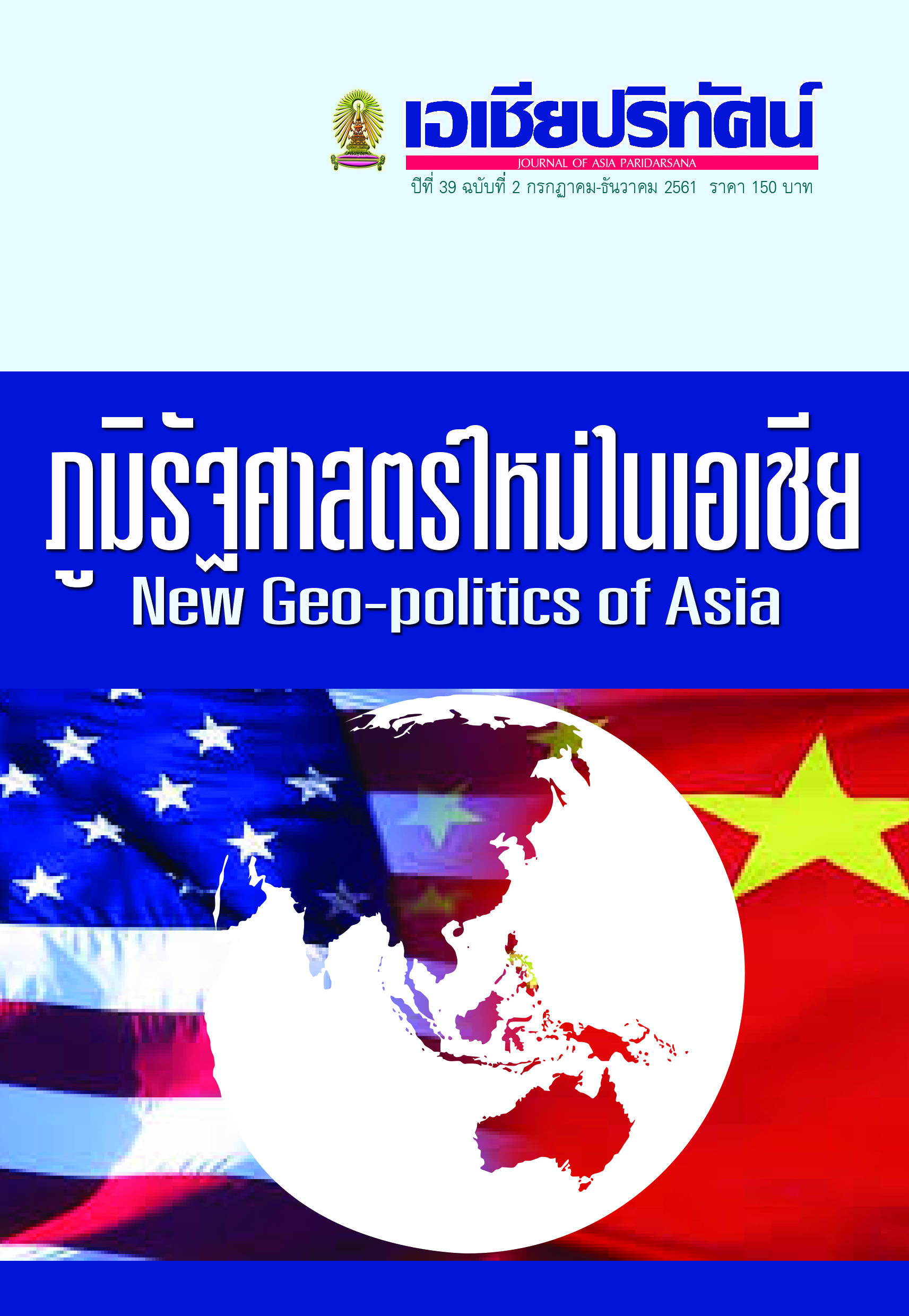ลัทธิสุดโต่งทางศาสนา: ศึกษา "เรื่องเล่า" ของไอซิสในเอเชียตะวันออกเฉียงใต้
Main Article Content
Abstract
The main objective of this article is to study extremist religious narratives, especially the narratives of ISIS in Southeast Asia. Understanding the narratives of extremists is important to any effort to prevent and counter the spread of extremist violence. The author argues that Islam is not a source or an inspiration for extremism; the extremists, rather, have exploited Islamic religious principles as a tool to achieve their political aims. The ISIS in Southeast Asia has, to some extent, utilized their narratives for recruiting and changing people minds by inducing them to accept their violent approach. The narratives of ISIS in Southeast Asia can best be divided into four categories, namely extremist political narratives, religious narratives, social narratives and the narratives on economic aspects. However, the main argument of this study is that all those extremist narratives being used by the extremists also exist in the mainstream Islamic principles. The question is how to differentiate between the extremist narratives and the Islamic principles adhered to by the majority of Muslim World. Failing to substantially acknowledge the differences between the two will cause fear or suspicion of Muslims and make it impossible to develop suitable “Counter-Extremist narratives”.
Article Details
References
“บทที่ 1 ความรู้พื้นฐานเกี่ยวกับศาสนา.” (มปป.) เข้าถึงเมื่อ http://www.mwit. ac.th/~social/files/ 55_1_doc_30101_1.pdf.
Abuza, Zacahry. 2015. “Joining the New Caravan: ISIS and the Regeneration of Terrorism in Southeast Asia.” Strategic Studies Institute, June 25. http://www.strategicstudies institute.army.mil/ index.cfm/ articles/joining-the-new-caravan/2015/06/25
“A Call to Hijrah.” 2014 Dabiq Magazine 2: 33.
“Advice for those Embarking Upon Hijrah.” 2014. Dabiq Magazine 3, http://muslimori1.blogs pot.com/2014/10/advice-for-those-embarking-upon-hijrah.html.
Bergin, Anthony, Sulastri Bte Osman, Carl Ungerer and Nur Azlin Mohamed Yasin. 2009. “Countering Internet Radicalisation in Southeast Asia.” Australian Strategic Policy Institute (ASPI), https://www.aspi. org.au/publications/special-report-issue-22-countering-internetradicalisation-in-southeast-asia/9_22_46_ AM_SR22_ Countering_ internet_ radicali sation.pdf
Banlaoi, Rommel C. 2012. Al-Harakatul Al Silamiyyah: Essays on the Abu Sayyaf Group. Manilla: Philippine Institute for Peace, Violence and Terrorism Research.
BIPSS. 2017. “Radicalisation: The Battle of Narratives and Counternarratives”. Commentary, May-2017. http://bipss.org.bd/index. php?option=com_content&view=article&id= 950:radicalisation-thebattle-of-narratives-and-counter-narratives&catid=9&Itemid=688
Chan, Anton. 2015. “The Call of ISIS: The medium and the message attracting South East Asians.” Counter Terrorist Trends and Analysis (7)4: 4–9.
El-Badawy, Emma, Milo Comerford and Peter Welby. 2016. “Inside the Jihadi Mind: Understanding Ideology and Propaganda.” http:// tonyblairfaithfoundation.org/religion-geopolitics/reports-analysis/ report/inside-jihadi-mind.
Esposito, John L. and Dalia Mogahed. 2008. Who speaks for Islam?: What a billion Muslims really think. New York, NY: Gallup Press.
Fernandez, Alberto M. 2015. Here to stay and growing: Combating ISIS propaganda networks. Washington, D.C.: The Brookings Institution. www.brookings.edu/~/media/research/files /papers/2015/10/combating-isis-propaganda-fernandez/is-propaganda_ web_english.pdf.
Gunaratna, Rohan. 2009. “The Current and Emerging Extremist Threat in Malaysia.” In Radical Islamic Ideology in South East Asia, Editer by
Helfstein, S. West Point: The Counter-Terrorism Center at West Point, 2 – 29. https://www.ciaonet.org /attachments/14599/uploads.
Gunaratna, R. and Hennessy, O. (2012) Through the Militant Lens: The Power of Ideology and Narrative. The Hague: International Centre for Counter-Terrorism. Retrieved from http://www.icct.nl/download/file/ICCT-Gunaratna-Hennessy-Through-the-MilitantLensJune-2012.pdf
Jager, Avraham. 2018. Does Poverty Cause Terrorism?. Herzliya, Israel: International Institute for Counter-Terrorism.
“Jund al-Khilafah in the Philippines—‘Training Camp.’” 2015. Jihadology December 20. http://jihadology.net/2015/12/20/ newvideomessage-from-jund-al-khilafah-in-the-philippines-training-camp/.
Hedayah and ICCT. 2014. “Developing Effective Counter-Narrative Frameworks for Countering Violent Extremism.” Hedayah Center, http:// www.hedayah.ae/pdf/developing-effective-counter-narrativeframeworks-for-countering-violent-extremism.pdf
Kibtiah, Tia Mariatul. 2016. “Mobilizations and Movements of Foreign Fighters from Southeast Asia to Syria and Iraq.” Journal of ASEAN Studies (4)1: 79-86.
Liow Chin Youg, Joseph “ISIS Goes to Asias” Foreign Affairs, September 19, 2014. http://www.foreignaffairs.com/articks/east-asia/2014-09-19/ isis-goes-asia
Ramakrishna, Kumar. 2005. It’s the Story, Stupid: Developing a CounterStrategy for Neutralizing Radical Islamism in South East Asia. London: Defense Academy of the United Kingdom, Research and Assessment Group.
Roy, O. 2016. The Islamization of Radicalism. Rosa Luxemburg Stiftung. http://www.rosaluxna.org/wp-content/uploads/2016/06/ Newsletter-oliver-roy-ENG-26-01-16.pdf
Schmid, Alex P. 2014. “Al Qaeda’s “Single Narrative” and Attempts to Develop Counter-Narratives.” January 14. The International Centre for Counter-Terrorism. DOI: http://dx.doi.org/10.19165/2014.1.01
Schmid, Alex P. and Albert J. Jongman. 1988. Political Terrorism: A New Guide to Actors, Authors, Concepts, Data Bases, Theories, and Literature. New Brunswick, NJ: Transaction Books
The European Wergeland Centre. n.d. “What is Extremism?.” www. theewc.org%2Fcontent% 2Fdownload%2F2055%2F18005%2Ffil e%2FWhat%2520is%2520extremism.pdf
Welby, Peter. 2015. “Inside the Jihadi Mind: Understanding Ideology and Propaganda.”https://institute.global/sites/default/files/inline-files/ IGC_Inside%20Jihad i%20Mind_ 18.08.17.pdf.
Welby, Peter. 2016. “What makes a religious extremist?.” http://tonyblairfaithfoundation.org/religion-geopolitics/commentaries/opinion/ what-makes-religious-extremist.
Winter, Charlie. 2015. ‘The Virtual ‘Caliphate’” Understanding Islamic State’s Propaganda Strategy.
London: Quilliam Foundation. http://www.quilliamfoundation.org/wp/ wp-content/uploads/ 2015/10/FINAL-documenting-the-virtualcaliphate.pdf
United Nations. 2005. UN Reform. Accessed April 27, 2007. https://www. unmultimedia.org/ tv/unifeed/?scriptId=73.


